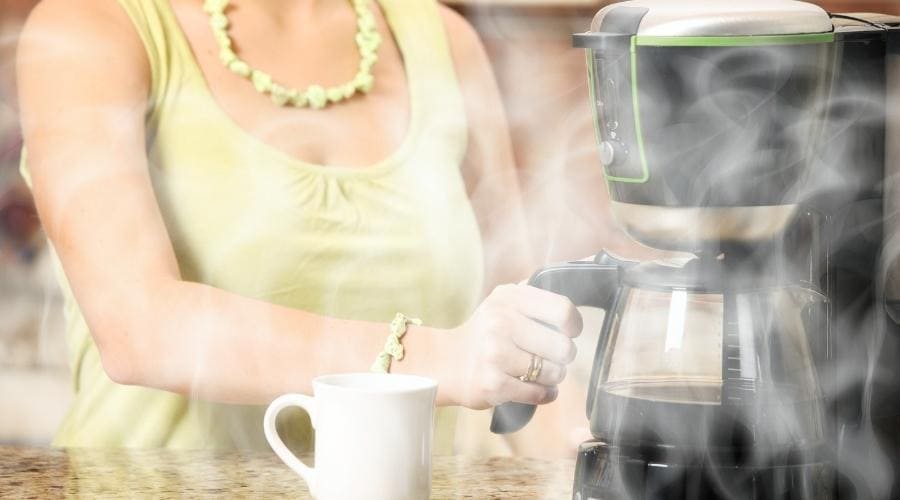
That steamy pot might just be a fan of James Bond! Jokes apart, excessive steaming in your coffee maker occurs due to various reasons. The key ones being: empty water tanks and dirt (or salt) build-up inside the coffee maker, which generally leads to a clogging issue.
In this article, I will get into more details regarding the reasons why your coffee maker steams Too much as well as quick and practical fixes. I will also provide some tips to avoid encountering the issue altogether.
Reasons why coffee makers steam too much?
Let me first quickly explain the inner workings of a coffee maker. This should help you understand the root cause of steaming.
- The water in the coffee maker is heated by a heating element (usually copper coil).
- A water conduct runs the hot water through the coffee grounds.
- The hot water picks up the coffee essence on its way down to the pot.
When the water conduct is obstructed, excessive steam keeps coming out. This issue is referred to as clogging.
Reason 1: Empty water tank
If the water tank of your coffee maker is empty, it won’t have enough hot water to pass through the coffee grounds. As a result, the coffee basket will be filled with steam.
- How to identify this problem? Your machine sounds as if it is coughing. Only steam comes out and no coffee.
- How to fix? Unplug the coffee maker immediately. And fill the tank with water.
Reason 2: Dirt within the coffee maker
Dirt accumulation blocks the hot water passages in the coffee maker. This forces your coffee maker to steam too much.
- How to identify the issue? The brewing pace of your coffee maker decreases along with increased steaming.
- How to fix the issue? Mix vinegar and water at 1:1 ratio. Run through your coffee maker. After you finish running the mixture, run two full cycles of plain water.
If the problem persists even after cleaning, you may have a clogged valve. It’s likely for coffee grinds to get trapped in the valves. This also slows the brewing pace.
In this case, you do need not to replace the valves. Just remove and wash it. Also make sure you place the valve back in the correct direction.
When your coffee maker heats up the water; magnesium, carbon dioxide and calcium molecules in the water are broken down. These molecules precipitate as calcium carbonates and magnesium carbonates.
The carbonates will then deposit on the walls of the machine. This is called scaling. Scaling clogs the coffee machine. It’s also referred to as lime scale build up.
Reason 3: Scaling
- How to identify the problem? Scaling slows down the coffee flow. The coffee maker steams too much. However, in these cases, the steam is released at a reduced pressure.
- How to fix the problem? Use a water filter system.
Reason 4: Group head is too hot
Generally located on the front area of the machine, the group head is the heart of any coffee maker. It’s main function is to bring water into the brewing basket. And it is controlled by a pressure stat or a thermostat. They are usually placed inside the outer casing.
The salt deposits and minerals in the water increase the load on these devices, and they start drawing more current. As a result, the increased current flow heats up the metallic parts in the group head. This excessive heat energy accumulates more steam inside the machine.
- How to identify the problem? Besides steaming too much, the machine produces a fizzing sound after flushing out the coffee.
- How to fix? Run a cycle with vinegar and water.
Reason 5: Molds
If you do not clean your coffee maker regularly, it becomes a breeding ground for molds. The inside of the coffee makers is warm and damp, which ideal for the molds.
- How to identify the issue? The coffee tastes weird. And sometimes, the machine starts making noises while brewing.
- How to fix the issue? Rinse your coffee maker at least twice a day. Clean it with vinegar and water at least once a month.
Reason 6: Use of hard water
The steaming problem is common if you live in an area with hard water. Hard water contains a lot of minerals. And when heated inside the coffee maker, it will deposit salt distillates.
These deposits settle within the walls of the coffee maker and clog the machine. Therefore, when you use hard water, you end up getting lots of steam and very little coffee.
- How to identify the issue? Test your water. You can do this by yourself. It is quite simple. Fill in 1/3 of a bottle with water. Add liquid soap. Shake vigorously. If the water is soft it produces lots of bubbles and clear water. If your water is hard, it produces very few bubbles with a cloudy texture.
- How to fix the issue? Use filtered water and water softening systems. Frequently clean the machine.
Reason 7: Too much steam due to coffee basket issues
In most coffee makers, the coffee basket can be disassembled for cleaning. Such models get clogged if you put too much coffee powder. That’s because the hot water is unable to pass through. This gives out little or no coffee but lots of steam.
- How to identify the issue? To check if your coffee basket is clogged, remove it and hold it up in front a bright light, the clogging should be apparent.
- How to fix the issue? Clean the basket using a brush and lemon juice. Make sure to apply gentle pressure. Most of these baskets are made of plastic, so they tend to tear off easily. General Tips: Clean the basket regularly. Add in the right amount of coffee powder. Leave enough space for the water to enter the basket.
Reason 8: Clogging in pause and serve mechanism
The pause and serve mechanism stops the coffee machine momentarily to help fill in multiple cups over a prolonged period of time. However, when this mechanism is clogged, steam starts building up in the brew basket.
- How to identify the problem? The coffee doesn’t flow fast. The flow is impeded. The steam blows out with an unusual gushing sound.
- How to fix? Run a brewing cycle using vinegar and water.
How to fix Cuisinart Coffee maker steaming problems?
The Cuisinart coffee makers are one of the popular brands in the market. They steam too much when they are clogged with calcium and chlorine. This problem is common if you use treated water.
How to identify this issue? Coffee is not dripping through the filters. All the water is boiled into steam. The refreshing smell of your coffee quickly goes away. Sometimes you will find dissolved solids and impurities in your coffee. The calcium blocks the passage and more steam is forced out.
How to fix the problem? Use a compatible charcoal filter. The charcoal filter traps the contaminants and removes the water treatment products such as chloramine and chlorine residues. Change the charcoal filter every 3 months.

Some of the Cuisinart coffee makers come with a built-in charcoal filter.
How to fix Mr Coffee steam problems?
The filters in Mr Coffee machine have fine screens with tiny holes. These screens are made of treated aluminum that scales naturally. With regular use over time, the scaled aluminum builds up and clogs the screen. The water is therefore unable to pass through the clogged filters. The machine ultimately gives out lots of steam and very few coffee drops.
- How to identify this issue? Your coffee maker starts spitting more steam along with water, but no coffee.
- How to fix the issue?
- Clean the machine and run a brewing cycle using vinegar and water. If you have not done this in a year, chances are, it won’t work the first time. So, you may have to do this at least twice. Once the issue is fixed, I suggest doing this at least once a month.
- There is another way you can fix this: Start a brewing cycle with vinegar and water. When you start seeing the machine beginning to drip into the pot, turn it off. Let it soak in the vinegar solution for an hour or two.
How to protect kitchen cabinets from the steam of a coffee maker?
The hot steam from the coffee makers is capable of degrading your kitchen cabinets over time. The following tips help to protect your kitchen cabinets from coffee maker steam:
Keep the kitchen ventilated.
If the moist air from the coffee maker has no outlet, it accumulates on cabinets and stove tops.
Install insulation sheets over your kitchen cabinets.
You can also use plywood or marine plywood coated with water proof materials. The steam from the coffee maker slides down the sheets instead of penetrating them.
Use high quality wood.
Good quality woods withstand moisture and humidity.
Use a thick finish of varnish:
Prolonged contact of steam will expand the wood. This will eventually distort them. Using a thick finish of varnish will protect your cabinets from dampness.
Place the coffee maker over a thick wooden stand:
If your cabinets are laminated, the steam from the machine may separate the glue that holds the lamination to the cabinet.
Install heat shields.
Heat shields are thermal barriers. They divert the steam away from your cabinets.
Make it a habit to wipe and dry your cabinets.
Steaming issues in coffee maker is quite common. If your coffee maker steams too much, it doesn’t mean it is broken.
Hope my tips and tricks help you fix your coffee machine effortlessly.
Enjoy your coffee!
